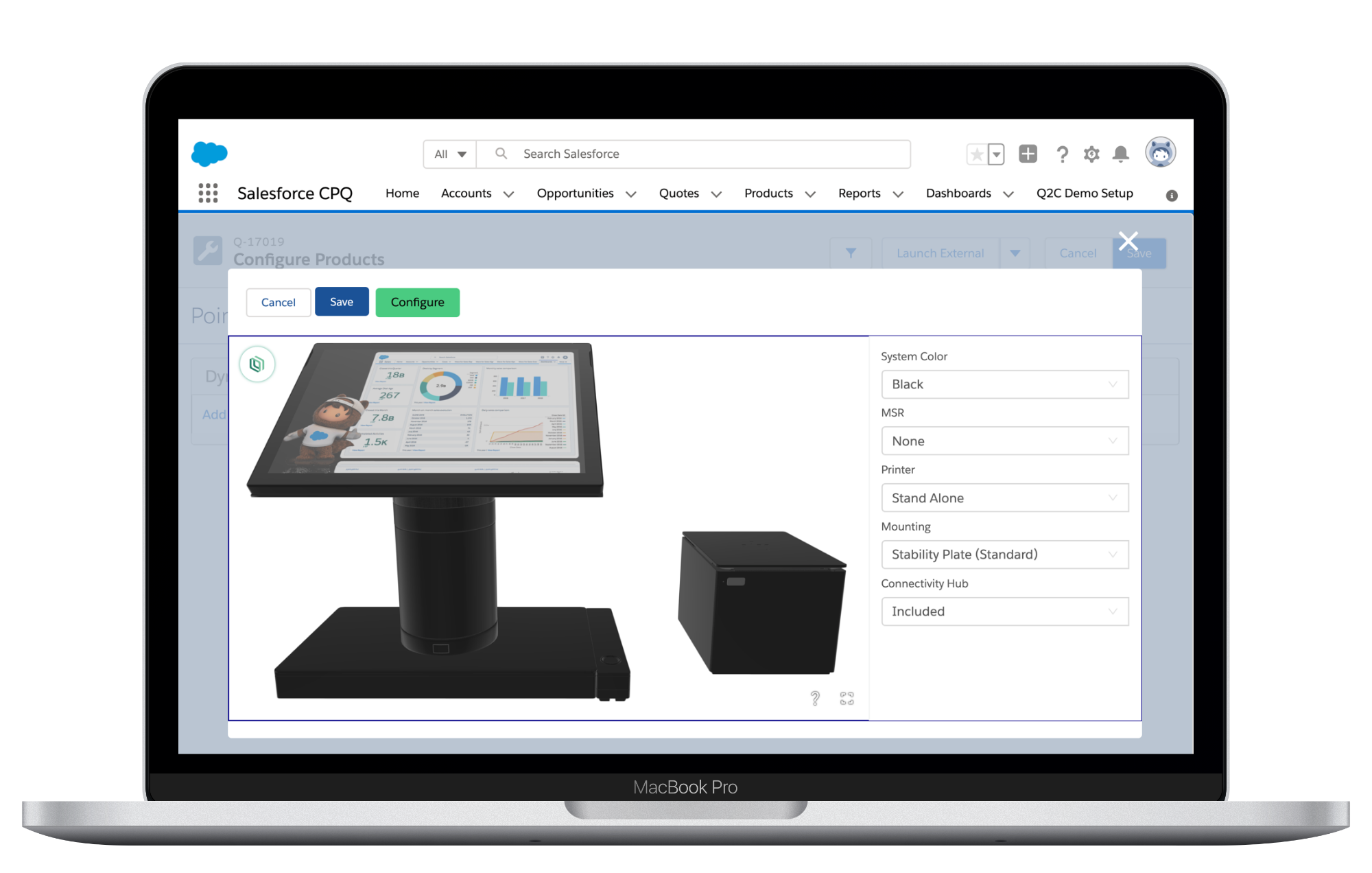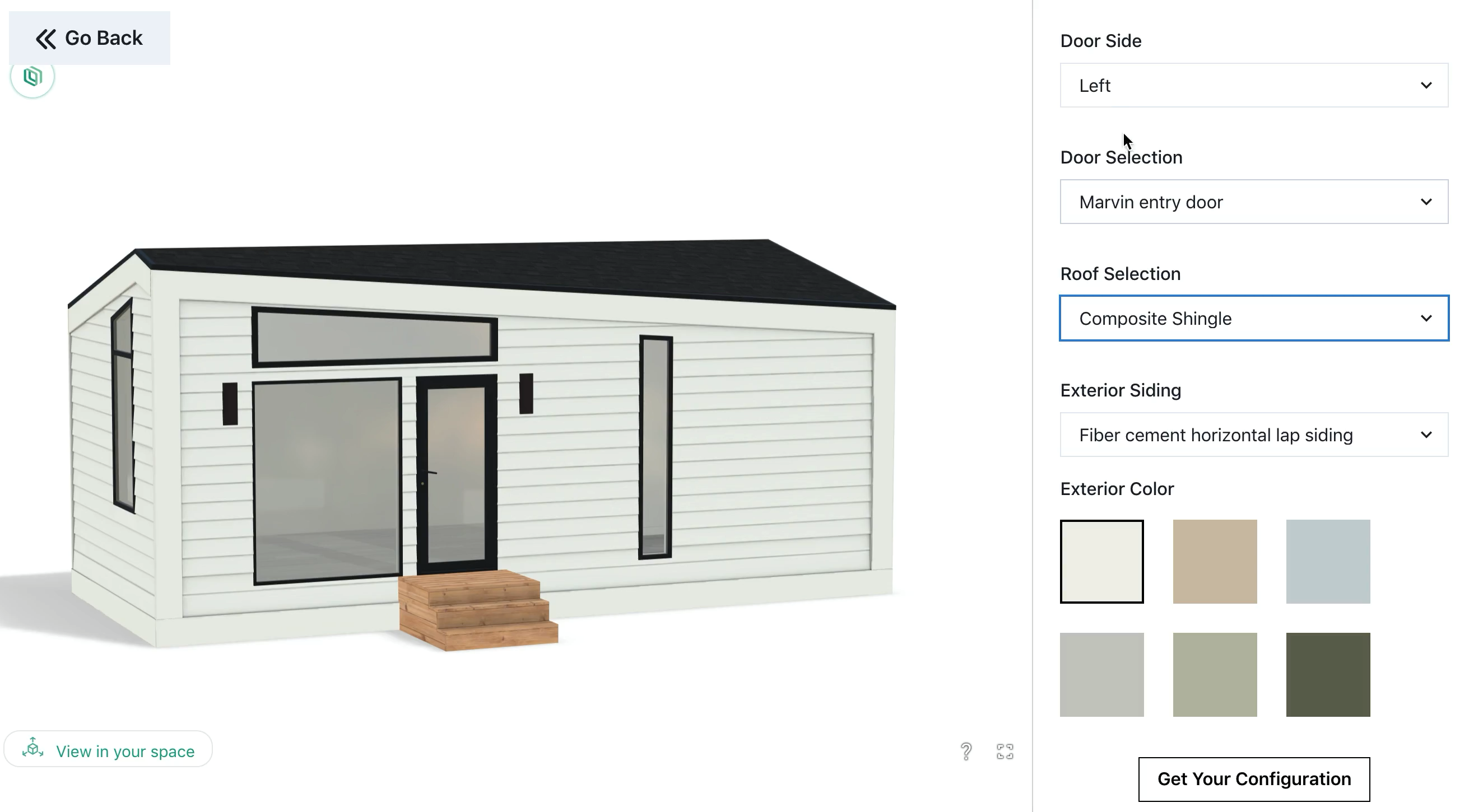How a Salesforce Product Configurator Improves Custom Door Shopping
Online business is booming, but a Salesforce product configurator can take your store to the next level. This is especially true for door manufacturers, where customers are particular about their product and can benefit from seeing it three-dimensionally and in a real space.
Key Takeaways
- A product configurator can simplify technical language, making the product more accessible and approachable.
- It can use a guided selling approach to prompt customers to configure their door to exact specifications, ensuring their chosen product meets their needs.
- With a Salesforce product configurator from Threekit, you can use Virtual Photographer to create an unlimited catalog of images showcasing each door's details, color options, and more.
- Augmented reality (AR) enables customers to see their configured door in their real space, boosting confidence and likelihood of a purchase.

The goods consumers are willing to turn to ecommerce for still has its limits. They generally shy away from buying important, expensive, or large and heavy items online. Especially for purchases like furniture and home remodel/renovation elements—like doors, windows or bathtubs—they tend to choose brick-and-mortar stores where they can see the item in three dimensions.
However, as TruFrame points out, the growing prevalence of online shopping tools and product solutions brings with it an increase in online sales.
Read on to learn seven pain points customers face when buying custom doors online and how adding a Salesforce product configurator can eliminate them all.
1. Unfamiliar and Overly Technical Terminology
Complicated language without explanation, like annealed and anodized, is an issue. Stores also used building terms like swing and rough open size that can be confusing to customers.
This makes something as simple as a door seem like too much of a complex product for the average person to understand.
A Salesforce product configurator lets you create different templates to guide the process. The first step, for example, can ask if they're contractors or consumers.
From there, consumers could both configure exactly what they're looking for using the most helpful language and providing the functionality each person needs while remaining user-friendly.

2. Unable to Find Suitable Educational Resources
With a Salesforce product configurator, you can let the template guide consumers through options using relevant questions. Alternatively, you can use the wide array of product visualization options to create video tutorials and infographics to explain the differences between products. You can even add hotspots to the images for additional information.
If they still have trouble understanding products, integrations to connect your CRM software to the Salesforce Sales Cloud make it easy to reach your sales team across platforms. Your sales reps can access their customer information database for context about past issues, and customers can get quick answers to their questions so they aren't configuring in the dark.
3. An Absence of Clear Information on Popularity, Design Trends, and Pricing
Customers want context regarding what gets recommended and what's in style. They can also disappointed with the lack of pricing model transparency. With every add-on, they have to wonder about the cost.
Our high-tech product configuration software can automate data collection about bestsellers, popular customization combinations, and much more. The Salesforce CPQ platform also has configure-price-quote automation for real-time quote generation. This means the customer can see exactly what the cost is for each selection they make.
This CPQ software streamlines workflow, saving small businesses time and money. Salesforce's CPQ solution is powerful alone, but when combined with Threekit's product visualization platform, real-time visual updates appear alongside the cost.

4. Lack of Focus on Design and Style
Both interior and exterior door buyers are driven to a door purchase for style reasons.
For exterior door consumers, especially, it's a key factor for almost all of them. Despite that, some sites don't have any real information or filter options for the features consumers care about most.
Using templates in a Salesforce product configurator, you can ask questions about color and style preferences to guide shoppers to the best options for their personal taste. They can avoid looking through hundreds of options they aren't interested in, and you increase conversions and customer experience metrics.
5. Images Don't Provide a Sufficient Level of Detail
Many customers mentioned that shopping online is how they begin the process and often where they make a purchase, but they still have to visit in-store showrooms. In part, that’s because the few images they're provided aren't from very close up, don't focus on details, and are of substandard quality.
With a Salesforce 3D visual product configurator, you can offer:
- Unlimited photorealistic images of every style and angle with our Virtual Photographer.
- High-quality 3D visuals with 360-degree views that customers can use to zoom in and rotate to see every element in perfect detail.
6. Images Have Limited Color Options
Sites typically have only a handful of images, often only of white doors. It may seem superficial, and some people don't understand the need for online colorizing because they assume color makes no difference.
The truth of the matter is that it can make a big difference. Some details are harder to see in darker colors. Color also changes how size is perceived and can make spaces seem bigger or smaller. Our Salesforce product configurator can create images of every door you sell in every style, color, and customization combination possible.
You can use virtual photography for simple things like style and color. But if you allow parametric or nested configurations, you can use interactive 3D Images that render the customers' choices as they configure in real-time.
Then they can see their unique creation exactly as they've designed it. It's like having an infinite product catalog for you, and a personal designer for the customer.

7. Inability to Visualize Options in Their Homes
Sometimes you can't tell if two styles mesh well together. Also, scale is important for doors. Seeing a door on a house will show those relationships. Many sites only have images of unattached doors.
Our virtual photos can easily create lifestyle images of your door on homes. We'll even do you one better: Show each customer door options on their own homes with augmented reality (AR).
Customers can see each door on/in their homes. They can see things like if it looks too plain or if the windows aren't high enough to provide privacy. This kind of insight is only possible through the kind of immersive and interactive experience AR provides.
Increased customer confidence in their door means increased likelihood of a purchase, and decreased likelihood of a costly product return.
The Ideal Path-to-Purchase for Custom Doors
Where Top Door Brands are Succeeding and Where They Must Make Strides to Meet Buyer Needs
Read the eBookSell a Door, Deliver More
Customers can feel frustrated with the difficulty and lack of options present in most online door buying processes. This gives you the opportunity to solve these pain points and become their favorite place to shop.
Not only will you sell more doors, but you'll get better customer experience metrics and more customer loyalty in return.
Get in touch to learn more about how Threekit's product customization platform can help your door business.


